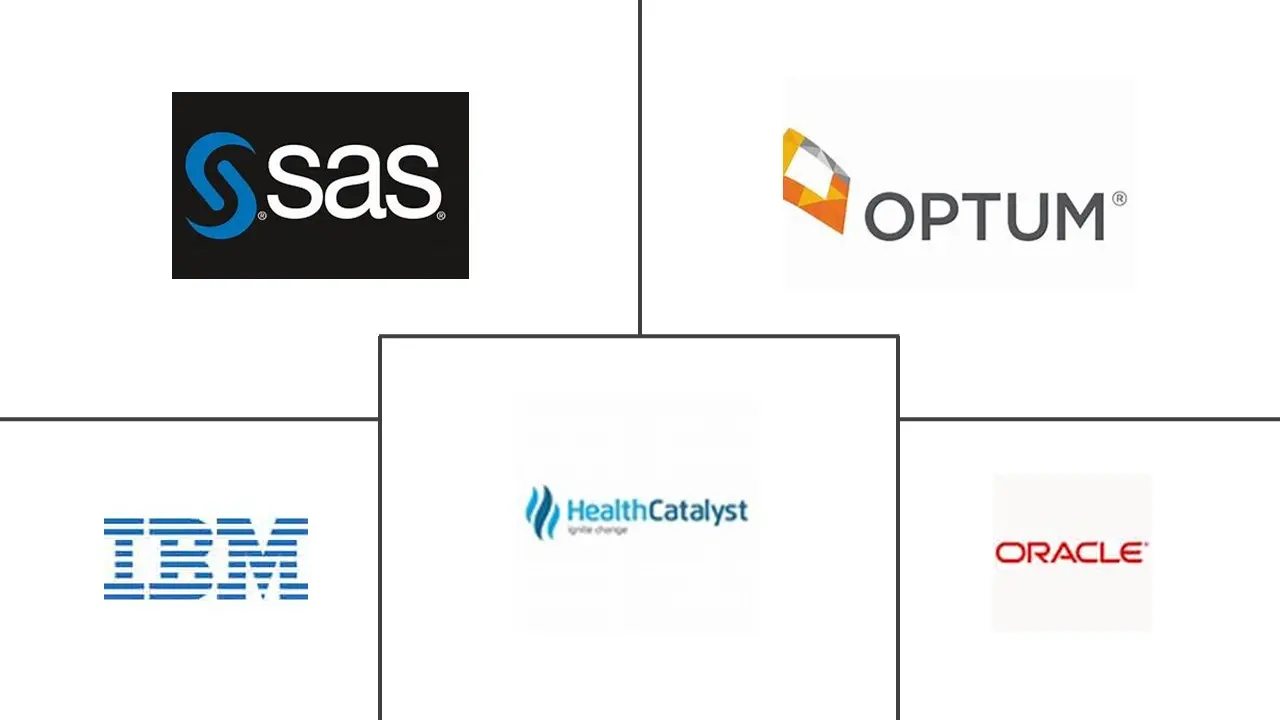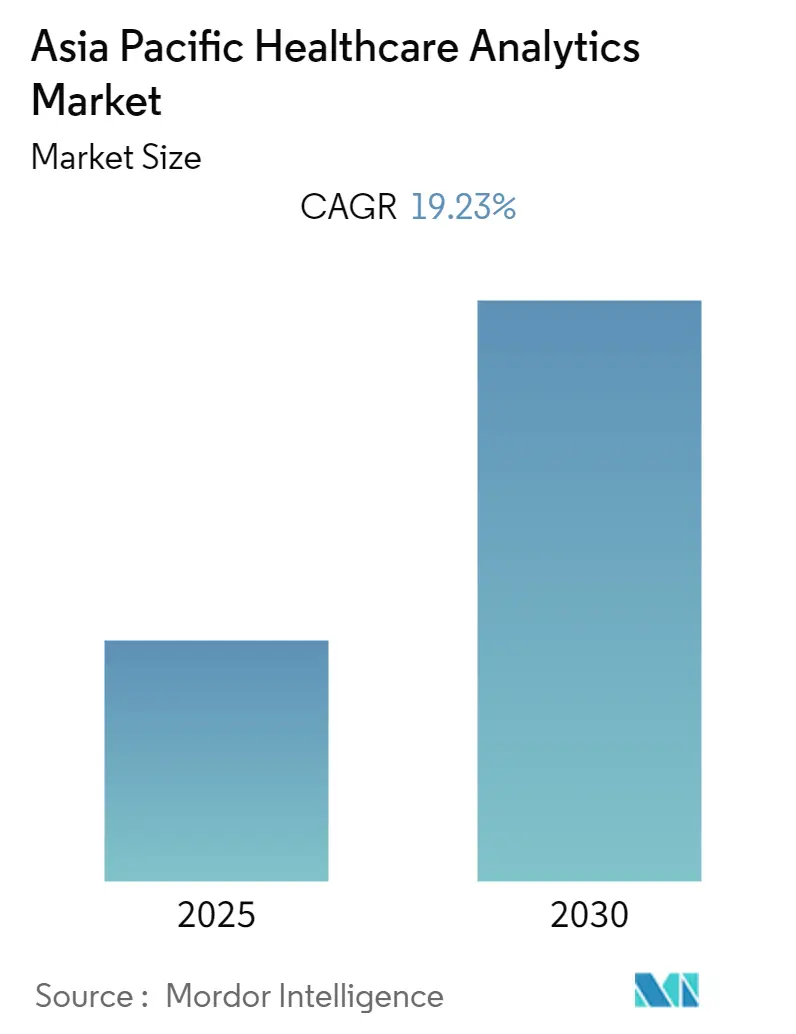
Asia Pacific Healthcare Analytics Market Analysis by Mordor Intelligence
The Asia Pacific Healthcare Analytics Market is expected to register a CAGR of 19.23% during the forecast period.
- There has been exponential growth in the healthcare analytics market due to the rise of the IT healthcare sector. Healthcare analytics can predict future trends, measure performance, and evaluate decisions using chronological data. This will help improve patient care by advancing accuracy, efficiency, and service delivery.
- The healthcare sector, in general, has been faced with challenges such as the need for improved patient care, rising treatment costs, and decreased patient retention. Consequently, healthcare analytics are getting integrated into every sector to provide better treatment to patients and improve industry operations. These are significant factors driving the expansion of the healthcare analytics industry.
- They are adopting big data analytics in healthcare, resulting in cost-effective medication, insurance planning concerning population health, and better diagnostic approaches. Because of this, there is an increase in the number of customers, leading to better investments in the sector.
- Security issues, technological and cultural barriers, and fragmented international political relations hinder the market's growth. The growth of the market is also slowed by the fact that most of the information sent in this sector is private.
- The COVID-19 outbreak increased the use of big data analytics for public healthcare surveillance and disease tracking. As a result, the sector in this region witnessed a significant boom owing to a rise in the necessity for digital solutions and improved analytics tools to handle the patient burden on the healthcare industry. The volume of clinical data collected during the pandemic required adequate management, and researchers and experts could extract better outcomes, forecast trends, and analyze disease transmission dynamics much better by using analytics tools and platforms.
Asia Pacific Healthcare Analytics Market Trends and Insights
Expanding IT sector and demand for improved medical services to drive the market
- The growing demand for remote patient monitoring solutions, owing to the aging population and long-term chronic disease conditions, is the primary factor impacting the growth of the market studied. There is constant pressure on hospital administrators to lower costs while continuing to improve the level of patient care. In this environment, hospitals are turning to modern technologies and analytics to operate more efficiently, support patient care, and improve patient experience. This is further driving the growth of the healthcare analytics market in Asia-Pacific.
- The widespread growth in health consciousness among consumers and an increase in chronic diseases have led to the adoption of cloud analytics to improve the efficiency of clinical operations and manage extensive medical data. Favorable governmental healthcare policies are also driving the market.
- For example, Japan provides universal insurance schemes and better healthcare at affordable prices to its citizens and residents for more than a year.This has increased the adoption of healthcare analytics in the country.
- Moreover, with the advent of information technology in Indian medical care, there is no intermediary to allow primary and secondary-level hospitals joint access to super-specialty hospitals. The new organizational model removes the middle class and provides an atmosphere that helps primary-level hospitals co-exist with super-specialty hospitals. This is a mutually beneficial situation for both partners.
- Confidence in health IT is increasing among healthcare consumers and providers. This has increased the consumption of applications and software that provide safe and reliable healthcare solutions without compromising sensitive data.
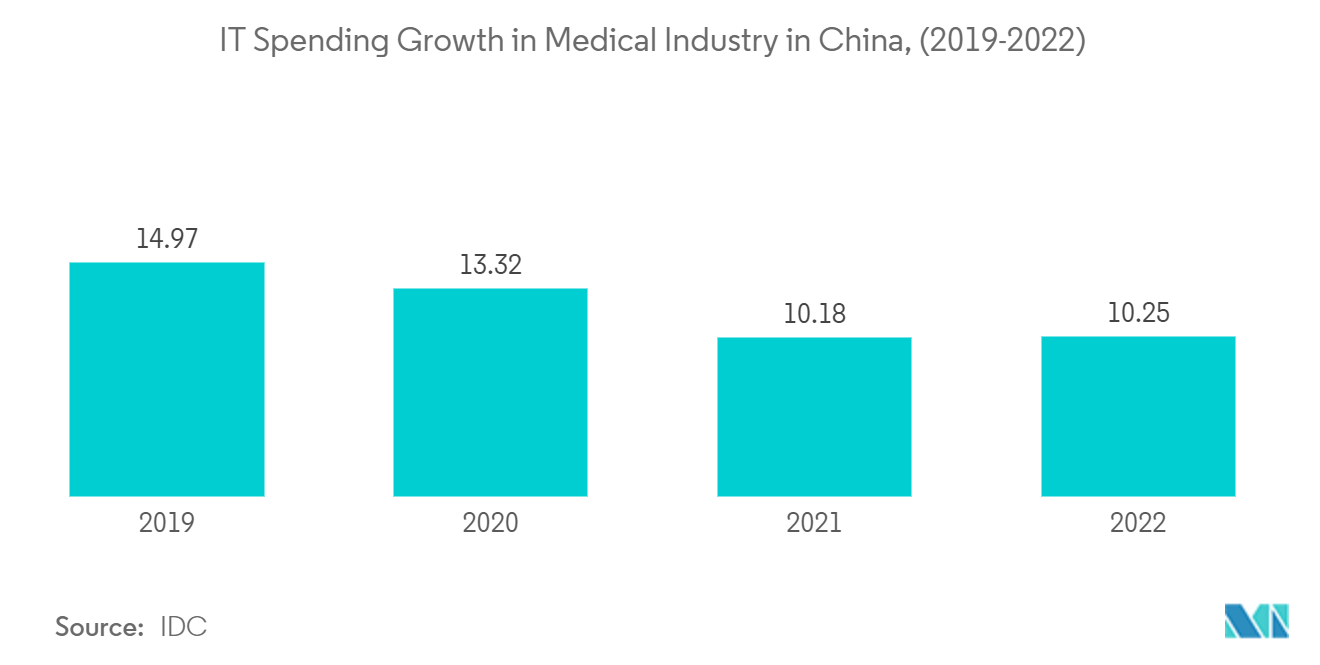
China and India to hold major shares in the market
- China and India drive the Asia-Pacific market by adopting IT solutions for healthcare and developing better IT skills. The demand for healthcare fraud analytics and detection in China is also growing with increased internet usage and technology in the healthcare sector. India is expected to register rapid growth in the market during the forecast period, whereas China holds a majority share in the Asia Pacific healthcare analytics market.
- Because of the spread of COVID-19 in India, the healthcare sector evolved quickly to meet the growing medical needs of consumers.There were government initiatives to digitize citizens' medical data in order to provide a transparent and efficient healthcare sector organization.This aided the growth of the healthcare analytics market in the country.
- An increase in the growth of infectious diseases is boosting the demand for healthcare analytics in China. The healthcare fraud analytics and detection market is also growing in China due to increased cases of medical insurance fraud. The development of infrastructure in the healthcare sector and a focus on new healthcare analytics by pharmaceutical companies are fueling the market's growth.
- For instance, in June last year, as part of its efforts to boost smart medicine and health, Xiamen, a city in east China's Fujian Province, developed a 5G-based telemedicine platform for eye diseases. The platform will be built by a 5G-powered eye hospital jointly established by Xiamen University's Xiamen Eye Center, China Telecom's Xiamen division, and Huawei. Based on 5G technology, the telemedicine platform will have medical images and videos that are updated in real time. This will let doctors do things like remote consultations, AI screening for eye diseases, and other ways to diagnose and treat patients.
- Also, in July last year, the Aster Innovation and Research Centre, the Aster DM Healthcare Group's innovation hub, collaborated with Intel Corporation and AI platform provider CARPL.ai to create and launch an AI-powered health data platform in India.
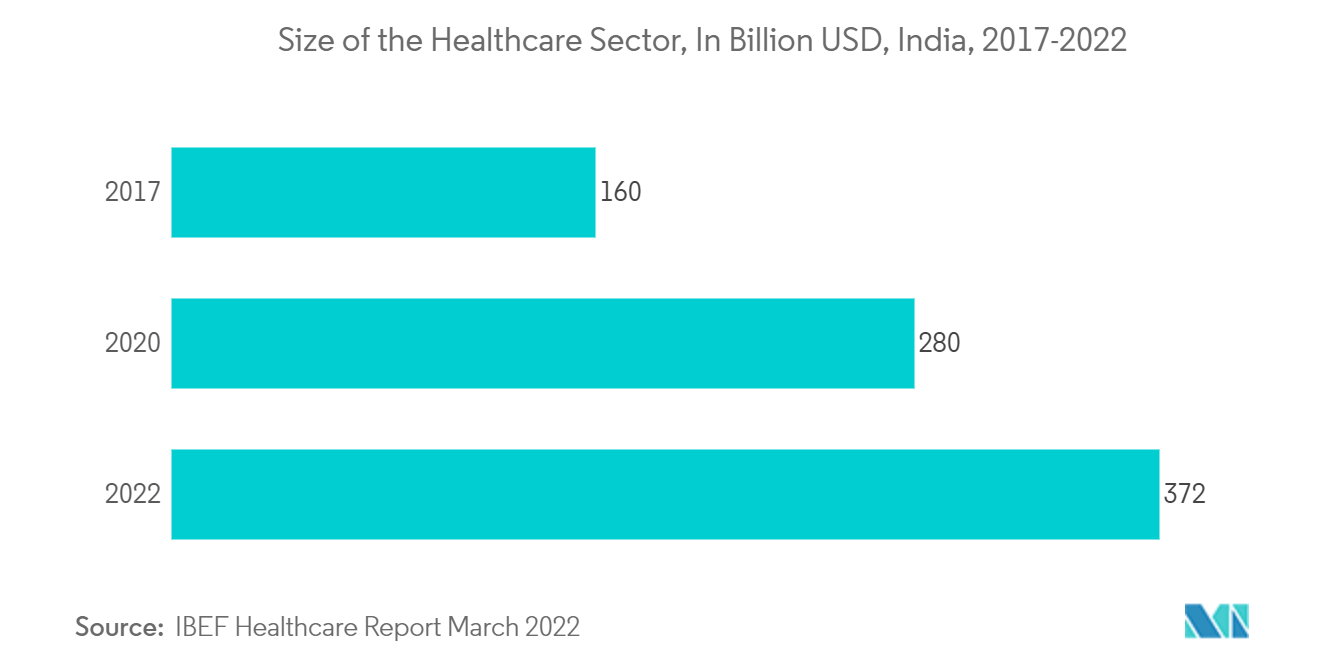
Competitive Landscape
Significant players like IBM Corporation, SAS Institute, Oracle Corporation, and Siemens Healthcare are bringing new trends into the healthcare analytics market. For example, the acquisition of Varian Medical System, Inc. by Siemens Healthineers provides the company segment with a promising outlook for the forecast period. In the recent past, SAS helped Nantes University Hospital Center use data visualization as part of a larger project to integrate financial affairs, human resources, and medical information and produce an in-house analysis of the costs per hospitalization.
In January 2023, Fujitsu and Sapporo Medical University announced the launch of a cooperative effort to achieve data portability for patients' healthcare data, including electronic health records (EHRs) and personal health records, beginning in April 2023.
Asia Pacific Healthcare Analytics Industry Leaders
-
Optum Inc
-
SAS Institute Inc
-
IBM Corporation
-
Oracle Corporation
-
Health Catalyst
- *Disclaimer: Major Players sorted in no particular order
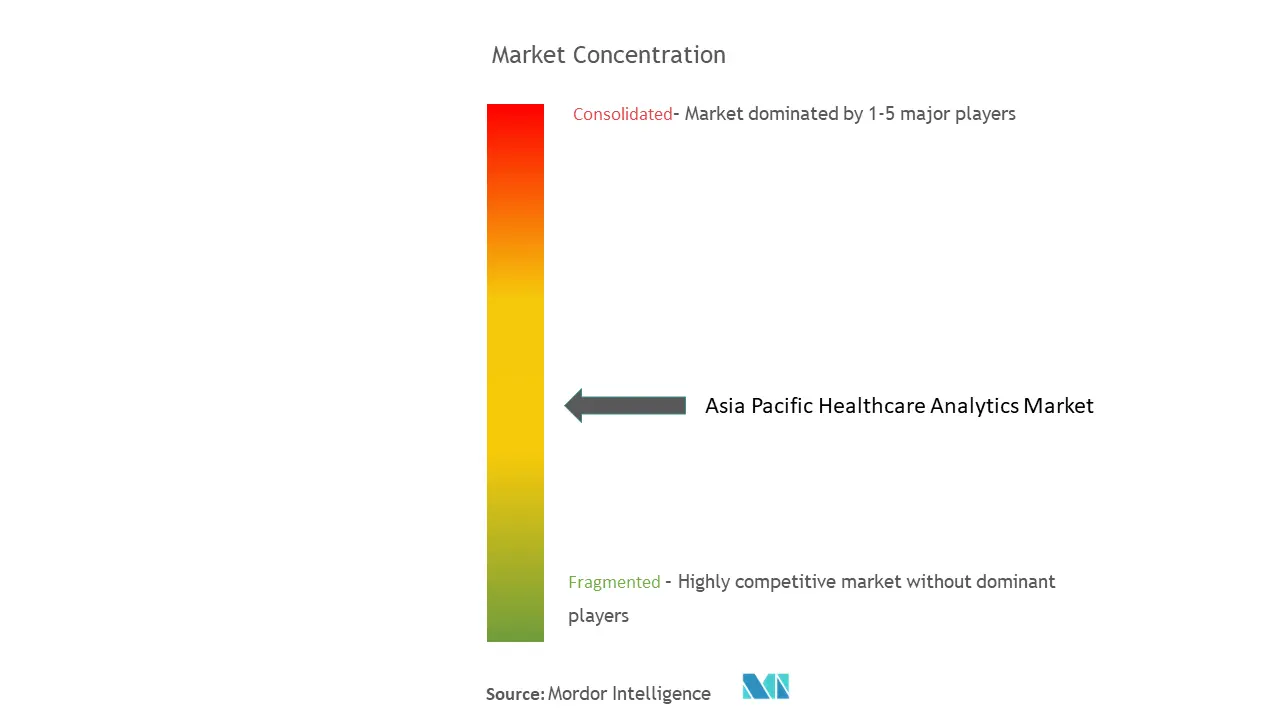
Recent Industry Developments
- March 2022: Optum, Inc. has introduced Optum Specialty Fusion, a specialty drug management solution that simplifies treatment for those using certain medications and minimizes pharmaceutical expenditures. According to the company, which is part of UnitedHealth Group, the method has the potential to achieve 17% overall cost reductions in health plans' medical and pharmaceutical costs.
- March 2022: Microsoft launched a cloud-based data platform for health care. The Azure Health Data Services platform-as-a-service (PaaS) assists organizations in managing various kinds of protected health information (PHI) across various data stores, allowing them to interact with and understand patient data with less time and resources.
Asia Pacific Healthcare Analytics Market Report Scope
Healthcare analytics, also known as clinical data analytics, is the branch of analysis that provides insights into patient records, hospital management, and diagnosis. Healthcare analytics permits the examination of patterns across multiple healthcare datasets to determine the improvement of medical care while limiting expenditure. The report examines the Asia-Pacific healthcare analytics market by application, including clinical, financial, predictive modeling, operational and administrative, and research; delivery mode, including premise, web-hosted, and cloud-based; components; and end users, including healthcare, payers, and providers.
The market sizes and forecasts are provided in terms of value (USD million) for all the above segments.
| On-Premise |
| Cloud |
| Clinical Data Analytics |
| Financial Data Analytics |
| Operational/Administrative Data Analytics |
| Healthcare Provider |
| Pharmaceutical Industry |
| Biotechnology Industry |
| Academic Organization |
| China |
| Japan |
| India |
| South Korea |
| Australia |
| Indonesia |
| Rest of Asia Pacific |
| By Deployment | On-Premise |
| Cloud | |
| By Application | Clinical Data Analytics |
| Financial Data Analytics | |
| Operational/Administrative Data Analytics | |
| By End-User | Healthcare Provider |
| Pharmaceutical Industry | |
| Biotechnology Industry | |
| Academic Organization | |
| By Country | China |
| Japan | |
| India | |
| South Korea | |
| Australia | |
| Indonesia | |
| Rest of Asia Pacific |
Key Questions Answered in the Report
What is the current Asia Pacific Healthcare Analytics Market size?
The Asia Pacific Healthcare Analytics Market is projected to register a CAGR of 19.23% during the forecast period (2025-2030)
Who are the key players in Asia Pacific Healthcare Analytics Market?
Optum Inc, SAS Institute Inc, IBM Corporation, Oracle Corporation and Health Catalyst are the major companies operating in the Asia Pacific Healthcare Analytics Market.
What years does this Asia Pacific Healthcare Analytics Market cover?
The report covers the Asia Pacific Healthcare Analytics Market historical market size for years: 2019, 2020, 2021, 2022, 2023 and 2024. The report also forecasts the Asia Pacific Healthcare Analytics Market size for years: 2025, 2026, 2027, 2028, 2029 and 2030.
Page last updated on:
Asia Pacific Healthcare Analytics Market Report
Statistics for the 2025 Asia Pacific Healthcare Analytics market share, size and revenue growth rate, created by Mordor Intelligence™ Industry Reports. Asia Pacific Healthcare Analytics analysis includes a market forecast outlook for 2025 to 2030 and historical overview. Get a sample of this industry analysis as a free report PDF download.
